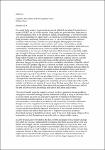Cognitive Innovation and the Cognitive Turn
| dc.contributor.author | Punt, Michael | |
| dc.date.accessioned | 2016-10-19T19:57:30Z | |
| dc.date.issued | 2015-10-24 | |
| dc.identifier.issn | 0024-094X | |
| dc.identifier.issn | 1530-9282 | |
| dc.identifier.uri | http://hdl.handle.net/10026.1/6577 | |
| dc.description.abstract |
For nearly half a century Leonardo has surveyed, reflected and shaped the intellectual project of ISAST. As part of this mission it has, in the best possible sense, been alert to ‘the next big thing’; what in the sciences is called a ‘breakthrough’, a ‘movement’ in the arts, and in technology an ‘opportunity’. In recent years in the humanities the ‘next big thing’ has been relentlessly labelled as a ‘turn’ to the extent that the term itself now resonates with self-irony. Nonetheless by tracking the bibliographies of various ‘breakthroughs’, ‘movements’, ‘opportunities’ and ‘turns’, it is possible to see the recurring pattern of secessionist impulses as they strive for recognition, build their own communities, launch conferences, sponsor journals and anthologies, appear in encyclopaedias to become an established presence that amounts to respectable middle age. A sceptical follower of Leonardo’s own passage from an engineering avant garde to glossy middle age can be excused for voicing a certain ennui as yet another ‘next big thing’ stakes its claim in a call for papers for a conference, a special issue or a special section. Yet without these calls, conferences and the generous energies of their advocates, the gravitational pull of disciplinary orthodoxy would have stifled the radical drive of the ISAST project long ago. Its salvation has been the platform it offers for risky discussions that are not bound by the routine rehearsals of questions and topics that are considered essential for training researchers to have disciplinary focus (and careers). This is how Leonardo began in Paris in 1968 and, in this sense, it was at the outset a transdisciplinary project ahead of its time; attempting to bring a different order to the open challenges to the conflicting paradigms of the arts sciences and technology. Through all the ‘breakthroughs’, ‘movements’, ‘opportunities’ and ‘turns’ it has, borne witness to the inexorable struggles with competing versions of what idea of the ‘world’ and the ‘real’ that we are sharing. In recent times this has, more often than not, returned us to familiar discussions of the bifurcations and paradigm conflicts between (and in) the arts and the sciences, technology and culture and theory and practice. | |
| dc.format.extent | 554-555 | |
| dc.language | en | |
| dc.language.iso | en | |
| dc.publisher | MIT Press - Journals | |
| dc.title | Cognitive Innovation and the Cognitive Turn | |
| dc.type | journal-article | |
| dc.type | Note | |
| dc.type | Journal | |
| plymouth.issue | 5 | |
| plymouth.volume | 50 | |
| plymouth.publication-status | Published | |
| plymouth.journal | Leonardo | |
| dc.identifier.doi | 10.1162/LEON_e_001194 | |
| plymouth.organisational-group | /Plymouth | |
| plymouth.organisational-group | /Plymouth/Admin Group - REF | |
| plymouth.organisational-group | /Plymouth/Admin Group - REF/REF Admin Group - FoAH | |
| plymouth.organisational-group | /Plymouth/Faculty of Arts, Humanities and Business | |
| plymouth.organisational-group | /Plymouth/Faculty of Arts, Humanities and Business/School of Art, Design and Architecture | |
| plymouth.organisational-group | /Plymouth/REF 2021 Researchers by UoA | |
| plymouth.organisational-group | /Plymouth/REF 2021 Researchers by UoA/UoA32 Art and Design: History, Practice and Theory | |
| plymouth.organisational-group | /Plymouth/Users by role | |
| plymouth.organisational-group | /Plymouth/Users by role/Academics | |
| plymouth.organisational-group | /Plymouth/Users by role/Researchers in ResearchFish submission | |
| dcterms.dateAccepted | 2014-12-09 | |
| dc.rights.embargodate | 2016-11-24 | |
| dc.identifier.eissn | 1530-9282 | |
| dc.rights.embargoperiod | No embargo | |
| rioxxterms.versionofrecord | 10.1162/LEON_e_001194 | |
| rioxxterms.licenseref.uri | http://www.rioxx.net/licenses/all-rights-reserved | |
| rioxxterms.licenseref.startdate | 2015-10-24 | |
| rioxxterms.type | Journal Article/Review |


